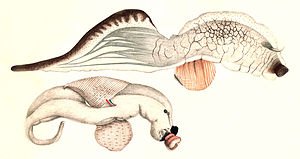Carinaria cristata
| Carinaria cristata | ||||||||||||
|---|---|---|---|---|---|---|---|---|---|---|---|---|

Live coloring of two Carinaria cristata from the Siboga expedition . Above, a 42 cm long animal without a shell that was found floating on the surface. In the lower specimen, the shell is present but positioned strangely low on the fuselage. The mouth is on the right, the round structure on the underside is the swim fin. The animals swim in reverse with the swim fin on top and the housing below. |
||||||||||||
| Systematics | ||||||||||||
|
||||||||||||
| Scientific name | ||||||||||||
| Carinaria cristata | ||||||||||||
| ( Linnaeus , 1767) |
Carinaria cristata is a pelagic living type of screw from the group of Kielfüßer (Schwimmfüßer).
description
Carinaria cristata is the largest of six species in the genus Carinaria . While Carinaria cristata can be up to 68 cm long, the closely related species (or subspecies) Carinaria japonica reaches a maximum size of 15 cm.
The case is conical, paper-thin, translucent and flexible when it is still fresh. The bowl is shaped like a pointed cap and flattened at the sides, with a small tip that is rolled back. The ribs are smooth, wavy and concentric and run down to a keel that is clearly visible from the inside.
The snails are separate sexes. The long, cylindrical body has a swim fin and is almost entirely transparent. At no point can it be withdrawn into the housing. The triangular, dark-colored visceral nucleus (intestinal sac with liver, testes or ovaries, heart and kidneys), the large eyes with their black retina, the jaws and the radula , as well as the intestine when it is filled with prey, are clearly visible . The tooth formula of the radula of Carinaria cristata is 2-1-1-1-2.
Occurrence
Carinaria cristata occurs in warm to temperate waters of the Indo-Pacific . The animals live in the upper layers of the sea, where they move about by swimming. Like all webbed feet, the animal swims upside down.
nutrition
Carinaria cristata mainly eats salps ( Doliolum denticulatum , Thalia democratica ), arrowworms ( Sagitta spp.) And planktonic snails (e.g. Thecosomata ), although cannibalism can occur, as well as crabs ( krill , copepods ) and, to a lesser extent, cnidarians (small state jellyfish : Nanomia bijuga , Muggiaea atlantica ) and fish (larvae of lantern fish ). The prey animals are typically half the length of the predator. They are swallowed whole and digested in the foregut, the digestion time being around 3 to 4 hours. The snail is mostly diurnal, possibly because it locates its prey with its eyes.
Enemies
The main enemies of Carinaria cristata are fish, including tuna , and turtles .
Research history
The shell of Carinaria cristata was described by Carl von Linné in 1767 in the 12th edition of the Systema Naturae under the name Patella cristata as a limpet . Johann Friedrich Gmelin called the animal Argonauta vitreus ("Glass Argonaut") in 1791 and thus assigned it to the paper boats , i.e. cephalopods . Jean-Baptiste de Lamarck established the name of the snail genus Carinaria in 1801 and also assigned this species to it under the name Carinaria vitrea .
literature
- Stanley Peter Dance: Ravensburger nature guide mussels and snails. Ravensburger, Ravensburg 1994, p. 75. ISBN 3-473-46079-6
Web links
- Marine Species Identification Portal. S. van der Spoel, LJ Newman & KW Estep: Pelagic Molluscs - Carinaria cristata forma cristata (Linnaeus 1766)
- Marine Species Identification Portal. S. van der Spoel, LJ Newman & KW Estep: Pelagic Molluscs - Carinaria cristata forma japonica Okutani, 1955
- Roger R. Seapy: Carinaria cristata (Linnaeus 1766)
- Photograph of Carinaria cristata
Individual evidence
- ↑ RR Seapy: Predation by the epipelagic heteropod mollusk Carinaria cristata forma japonica. Marine Biology 60 (2-3), 1980, pp. 137-146.
- ↑ Takashi Okutani: Notes on the genus Carinaria (Heteropoda) from Japanese and adjacent waters. Publications of the Seto Marine Biological Laboratory 9 (2), 1961, pp. 333-252.
- ↑ Carolus Linnaeus : Systema Naturae , 1766, Vermes, p. 1260, no. 768 ( digitized version ).
- ^ Johann Friedrich Gmelin : Caroli a Linné systema naturae per regna tria naturae, secundum classes, ordines, genera, species, cum characteribus, differentiis, synonymis, locis ... Editio decima tertia, aucta, reformata . Georg Emanuel Beer, Leipzig 1788–1793. Part 6: Vermes (1791), p. 3368.
- ^ Jean-Baptiste de Lamarck : Système des animaux sans vertebres, ou tableau général des classes, des ordres et des genres de ces animaux; présentant leurs caracteres essentiels et leur distribution, d'apres la considération de leurs rapports naturels et de leur organization, et suivant l'arrangement établi dans les galeries du Muséum d'Hist. Naturelle, parmu leurs dépouilles conservées; précédé du discours d'ouverture du Cours de Zoologie, donné dans le Muséum National d'Histoire Naturelle l'an 8 de la République. Paris 1801. p. 99 .